(Note: These are the original designs for "reduced complexity" mousetraps that I posted several years ago. In spring 2002 I posted drawings of new and improved mousetraps.)
Creationist Michael Behe has been attracting a lot of attention recently with his advocacy of the "intelligent design" argument. He makes the claim that certain biochemical processes are "irreducibly complex": they involve multiple proteins, the removal of any one of which would destroy the function of the overall pathway. From this he concludes that these pathways could not have evolved through the action of natural selection, but instead must have been created by an "intelligent designer."
To illustrate the concept of irreducibly complexity, Behe uses the common snap mousetrap. "If any one of the components of the mousetrap (the base, hammer, spring, catch, or holding bar) is removed, then the trap does not function. In other words, the simple little mousetrap has no ability to trap a mouse until several separate parts are all assembled. Because the mousetrap is necessarily composed of several parts, it is irreducibly complex." (Behe, 1996).
It is not my purpose here to point out all of the philosophical flaws in Behe's argument; this has been done thoroughly in many of the resources collected on John Catalano's excellent web page, "Behe's Empty Box." Instead, I wish to point out that the mousetrap that Behe uses as an analogy CAN be reduced in complexity and still function as a mousetrap. The mousetrap illustrates one of the fundamental flaws in the intelligent design argument: the fact that one person can't imagine something doesn't mean it is impossible, it may just mean that the person has a limited imagination. Behe's evidence that biochemical pathways are intelligently designed is that Behe can't imagine how they could function without all of their parts, but given how easy it is to reduce the complexity of a mousetrap, I'm not convinced. (Of course, the reduced-complexity mousetraps shown below are intended to point out the logical flaw in the intelligent design argument; they're not intended as an analogy of how evolution works.)
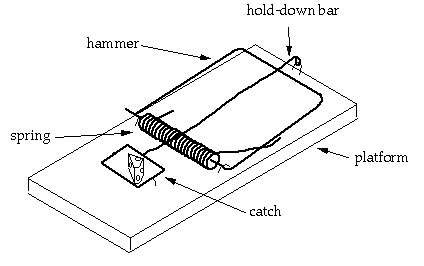
A five-part mousetrap. This is a snap mousetrap, shown ready to catch a mouse. It has five main parts: a hammer, which kills the mouse; a spring, which snaps the hammer down on to the mouse; a hold-down bar, which holds the hammer in the cocked position; a catch, which holds the end of the hold-down bar and releases it when the mouse jiggles the catch; and a platform, to which everything else is attached. (The bait is not one of the "irreducible" parts of the mousetrap, since an unbaited trap will catch the occasional mouse that stumbles into the catch.)
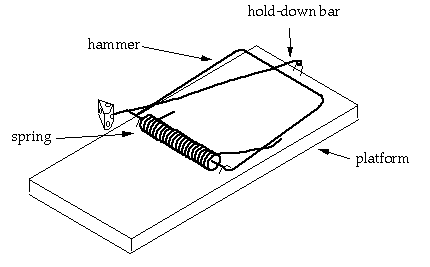
A four-part mousetrap. The first step in reducing the complexity of a mousetrap is to remove the catch. The hold-down bar is then bent a little so that it will catch on the end of the hammer that protrudes out from the spring; this end of the hammer might need a little filing to make the action nice and delicate. I've made one of these by modifying a regular mousetrap, and just like the five-part mousetrap, it snaps with mouse-killing force when I jiggle the bait with a pencil.
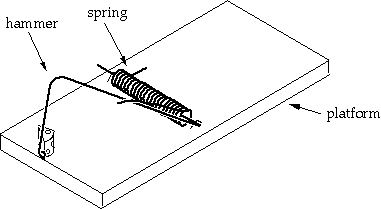
A three-part mousetrap. The next step is to remove the hold-down bar and bend the hammer so that one end is resting right at the edge of the platform, holding the hammer up in the cocked position. This is not as good a mousetrap as the four-part mousetrap. It is difficult to put the hammer exactly on the edge of the base, so a mouse-sized jiggle will cause it to snap. When it does snap the hammer hits the floor and sends the trap flying, possibly tossing the mouse to safety. But I've made one by modifying a regular mousetrap, and it snaps just as hard as a five-part trap.
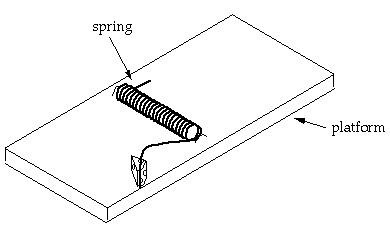
A two-part mousetrap. The next step is to remove the hammer and bend the straight part of the spring to resemble the hammer of the three-part mousetrap. When I made one of these, I didn't straighten any coils, so the gap is just big enough for a mouse's paw or tail. A mouse would have to be pretty unlucky to get caught by this trap. If you could straighten out a few coils of the spring (which is easier said than done--mousetrap springs are pretty tough), you could make a two-part trap that was basically the same as the three-part trap.
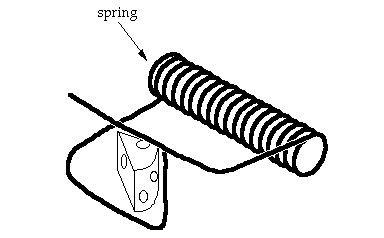
A one-part mousetrap. I can think of at least a couple ways to make a one-part mousetrap from the two-part mousetrap. One would be to remove the spring and spread glue on the platform; you'd then have one of those barbaric glue traps that holds the mouse in place until it dies of thirst. The other way would be to straighten out a few coils of each end of the spring. One straight piece of the wire would then be bent so the end points up; the other piece of wire would come across and rest delicately on the upraised point. I don't have the wire-bending skills to make one of these, but if I did, I think the unlucky mouse that was standing under the top wire when it jiggled the trap would be just as dead as if it were killed by the much more complex five-part mousetrap.
Return to John H. McDonald's home page
Send comments to John H. McDonald (mcdonald@udel.edu).
This page was last revised January 13, 2003. Its URL is http://udel.edu/~mcdonald/mousetrap.html